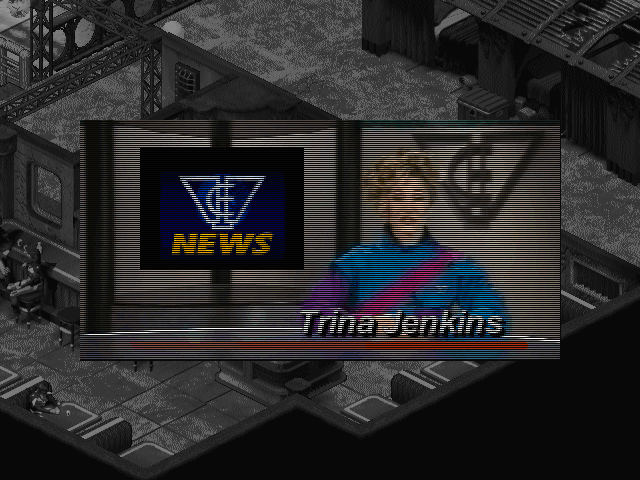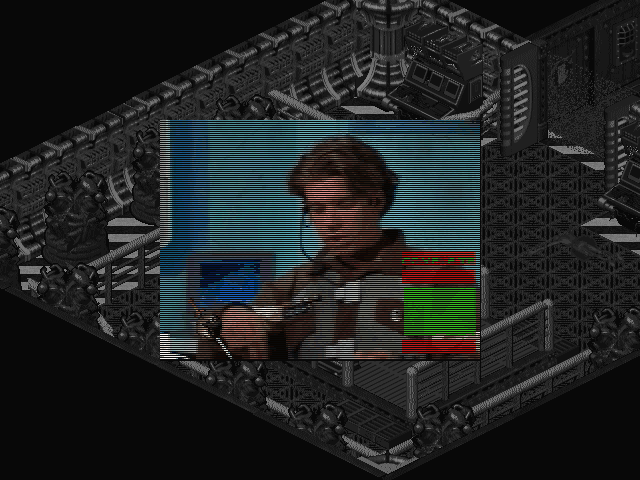



This future is all dark and cyberpunk. The world is engulfed in a social disaster, with everything being under control of the World Economic Consortium (WEC). Ruling with iron hand, they've put the nations in stranglehold with unbearable taxes, vicious military operations and continuous terror against the ones who dare to differ. At their service is a powerful elite force of Silencers - clad in red full body armors, holding the most powerful firearms that WEC has to offer, their mission is to crush the resistance and uphold the prosperity of WEC's tyrannical regime. But then there is one of them, an unnamed hero who betrayed the Silencer corps and joined the underground. Bringing hope to the rebels, he decided to assist them in crushing the government by any means... and with no remorse.

These fuckers are so evil they don't even cast sexy anchorwomen.
Sounds corny? Well, the game itself is anything but. That was the backstory of one of the finest 2D action-adventures ever released.
Throughout the 80s and early 90s, the legendary Origin Systems was best known for their RPGs (Ultima, System Shock) and simulators (Wing Commander, Strike Commander), but after some criticism around their 'intellectual' games leaning more and more towards pure action, the studio executives listened to vox populi and decided to launch a new shooter franchise under the direction of Tony Zurovec (of Ultima 7-8 fame). Five games were planned to surface, although only two of them were actually developed: Crusader: No Remorse and Crusader: No Regret.
No Remorse opens with three Silencer units returning back from the mission they've abandoned by refusing to shoot unarmed civilians. They are ambushed by the WEC robotic assassin, and two Silencers are killed. As the third one (who happens to be our hero) manages to take the mech down with a grenade, he then proceeds towards the dying robot to give him his finishing headshot - this is where the game logo and main menu come in. What follows is outrageous, good old gory violent fun with a touch of intelligence here and there.
Basically, the Crusader games are isometric shooters not unlike Alien Shooter, Skeleton Krew, Project Overkill, or even a little bit of Diablo (played as the Amazon), but with extensive adventure elements: the levels are nonlinear, objective-based, backtrack-heavy and usually consisting of several floors. The game does a decent job at not being too boring and/or redundant, because the objectives are very variable and rarely resort to killing 'em all, with the environments gradually becoming more and more complex, and sometimes requiring running for miles from corner to corner to check if some last switch or necessary terminal was triggered. For the most time, you'll be walking around the maps, flipping the switches, bypassing the security cams and turrets, hacking into PCs, occasionally solving simple puzzles and of course, gunning down those WEC bastards. There are plenty of ways to accomplish the latter - machine gun, shotgun, grenade launcher, spider bombs, all kinds of energy-powered weapons, and the list goes on. The game is also notable for its interactive destructible environments - a good majority of things you see onscreen can be blown up and used in combat this way. You can even control enemy mechs and exterminate the WEC troops remotely! You're even permitted to shoot the unarmed employees, to they can drop useful loot and be unable to trigger the alarms. Yes, alarms - the game also has some touches of stealth action injected within.
The Silencer is controlled in a remotely similar way as the early Resident Evil games, so you'll need some time to get used to it, but in the end everything turns out to be handled pretty conveniently (even on PSP). After you've completed whatever was required for a mission, you'll find yourself back at the rebel base. Here you can buy weapons and supplies, read emails and progress through the story. In the PC version, you're free to walk around and speak to anyone you want - the leader, the arms dealer, rescued comrades, etc., while in the PS1 version, the base map is redone - but we'll get to the differences later.
In between all the bloodshed, you'll be watching surprisingly decent FMV cutscenes (of course, Origin was always famous for their videos, though don't expect to see Mark Hamill or Malcolm McDowell here).

You knew this was coming.
Surprisingly, the acting is way better than your average 3DO games of the time, and the CG elements do not really stick out. Overall, the story is paced really good, and the characters, while nothing Shakespearean, are still fun and memorable. My personal fave is hands-down Troy 'Wizard' Reaves, the hacker responsible for inserting and extracting the Silencer between the battlegrounds and rebels base, as well as trolling his compatriots via email with chicken jokes and proudly carrying his kewl rad 90s hairdo.

Where is my Power Glove?
The Silencer himself is essentially a badass silent protagonist, along the lines of Boba Fett (see below), Master Chief (the ambiguous identity) and the DoomGuy (his screams and grunts are obviously male, so no 'Samus is a woman' twists here), a killing machine trained to be capable of waging any kind of warfare alone, and too bad that his bosses allowed his will and skill to be turned on themselves.

No Boba Fett. I am not your clone.
Powered by the Ultime 8 engine, the SVGA graphics are likeable for a DOS game, though at the first glance, levels consist of mostly the same prefabs over and over again. Still it's acceptable for something released around 1995, and despite some initial negative impressions, the backgrounds grow more and more varied towards the end. The animations are quite fluent and realistic, though there's not as much gore as No Remorse's reputation goes (fixed in No Regret). You can still make the enemies run around burning, blow them up with spider bombs or just stuff with hot lead, which will result in gibs and puddles of blood. The pixel art has a 'pre-rendered' style, highly reminiscent of Fallout 1-2, and it still looks alright on giant PC monitors, as well as on TV or PSP screens.

And one thing remains perfectly clear: if you don't have the ATTITUDE, you don't have a chance!
On par with the visual designs is the music by Andrew 'Necros' Sega (who later became famous for his contribution to the Unreal soundtracks) and his gang at Straylight. The title theme alone is one of the catchiest MOD tacks ever, not to mention that the tracker music itself was a pretty new thing back then. As a result, we have a brilliant electronic OST in super-quality, occupying a bit less than 4 MB! It's so energizing, it makes taking down the enemy forces even more fun.
The game was initially released on PC, later ported to PlayStation and Saturn. Unfortunately, I had no chance to check out the Saturn version, so the differences I'm going to list span only between PS1 and DOS. In the PC version, backgrounds do not scroll at all, they are only shifted by a certain distance. The PlayStation, on the other hands, has smooth scrolling all the way, making gameplay less jerky and more fluent. But the cutscenes in the PS1 version are a bit reduced in quantity, and mission briefings do not occupy full screen. As the rebels base is presented there like a bitmap background with hotspots (makes me think of Phantasy Star Universe vs. Phantasy Star Portable, actually), the dialogue cutscenes are replaced with additional emails that the Silencer is receiving between missions. The HUD is different between both versions, also the music shuffles annoyingly when entering and exiting the menu in the PS1 version, which does not happen in DOS. So despite some nitpicks and graphics aside, I'd say that the PlayStation version plays a little better, but obviously lacks in presentation.

Remember! No attitude = no chance! (I was really desperate to insert the 'blow shit up' word combination here, but still cannot think of a way. Well yay, you can blow shit up in this game!)
While Crusader: No Remorse is a fantastic game, unfortunately it is not flawless. Like I said, the first few missions are a little boring, mostly because of the recycled prefabs. It doesn't get really interesting until around the middle - that's where the plot twists begin, that's where the enemies gain variety, and the environments get pleasantly tricky. The physics model is a bit off, and no scrolling in the PC version is a bit disappointing, while the constant music shuffle is disappointing on the PS1. Also, some may be turned down by poor joystick/gamepad support and over-the-top controls - but the latter's excusable, given the usual Origin's habit of designing complex games with lots of options and available actions.
Crusader: No Remorse was favorably received at the time of release, winning the GOTY award from Computer Gaming World and being showered with their honorary awards later on. Also, the German magazine GameStar included it in its Top 100 list of 'the most important PC games of all time', despite the game itself having undergone heavy censorship in that country. It still remains a sort of cult classic between the old-school gamers, and I can guarantee that every time you bring it up in a conversation with them, at least one participant will go 'Oh yeah'. I know, I tried it! For example, here's what the fellows at shmups.com forum had to say:
I remember being blown away by this demo back in the day. [...] Glad you brought it up though, might have to dig up the full versions.
I loved the Crusader series back in the day. Played through the first one several times and sequel once or twice. Not run 'n guns in the arcade sense, [...] but still very fun games.
And Crusader: No Remorse will soon be available from GOG.com so I'll probably play through it one more time.
The Crusader games are personal favorites of mine. No Regret in particular is a strong candidate for my desert island game. I love almost everything about it. I've even gotten to the point where I derive a certain pleasure from the acted cutscenes ("Get to the tubeway system on level three! The prisoners are located on level five!").
I cannot possibly overpraise this game, it's this good. It's not super-hard or anything, and most likely the younger gamer masses of today won't appreciate the pixelized rendered graphics and nerve-racking gameplay, but if you're in for some good old-school run-n-gun action adventure, this is what the doctor ordered. It's still fast and intense, ridiculously interesting to play and addicting as all hell. Whether it's your 486 laptop, modern day PC with DOSBox (or GOG.com edition, see below), Saturn or PS1/PSP, Crusader will be welcome in the game library of any 2D shooter fan.
P.S. Grab the whole dilogy from GOG.com, like, now! With bonuses!




No comments:
Post a Comment